Inbox and Environment News: Issue 442
March 15 - 21, 2020: Issue 442
Kookaburra Fledlings This Week; Big Snake Eaten By Little Bird
photos taken Thursday March 12th, 2020
Pittwater Spotted Gums Gilded By Late Afternoon Autumn Light
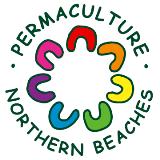 PNB hold monthly permaculture related events on the last Thursday of each month at the Tramshed Community Arts Centre, Lakeview Room., 1395A Pittwater Road, Narrabeen. Buses stop directly at the Centre and there is also car parking. Doors open at 7:15 pm. Meetings are February to November.
PNB hold monthly permaculture related events on the last Thursday of each month at the Tramshed Community Arts Centre, Lakeview Room., 1395A Pittwater Road, Narrabeen. Buses stop directly at the Centre and there is also car parking. Doors open at 7:15 pm. Meetings are February to November.Please Help Sydney Wildlife Rescue: Donate Your Cans And Bottles And Nominate SW As Recipient
You can Help Sydney Wildlife help Wildlife. Sydney Wildlife Rescue is now listed as a charity partner on the return and earn machines in these locations:
- Pittwater RSL Mona Vale
- Northern Beaches Indoor Sports Centre NBISC Warriewood
- Woolworths Balgowlah
- Belrose Super centre
- Coles Manly Vale
- Westfield Warringah Mall
- Strathfield Council Carpark
- Paddy's Markets Flemington Homebush West
- Woolworths Homebush West
- Caltex Concord road Concord West
- Bondi Campbell pde behind Beach Pavilion
- Westfield Bondi Junction car park level 2 eastern end Woolworths side under ramp
- UNSW Kensington
- Enviro Pak McEvoy street Alexandria.
Every bottle, can, or eligible container that is returned could be 10c donated to Sydney Wildlife.
Every item returned will make a difference by removing these items from landfill and raising funds for our 100% volunteer wildlife carers. All funds raised go to support wildlife.
It is easy to DONATE, just feed the items into the machine select DONATE and choose Sydney Wildlife Rescue.
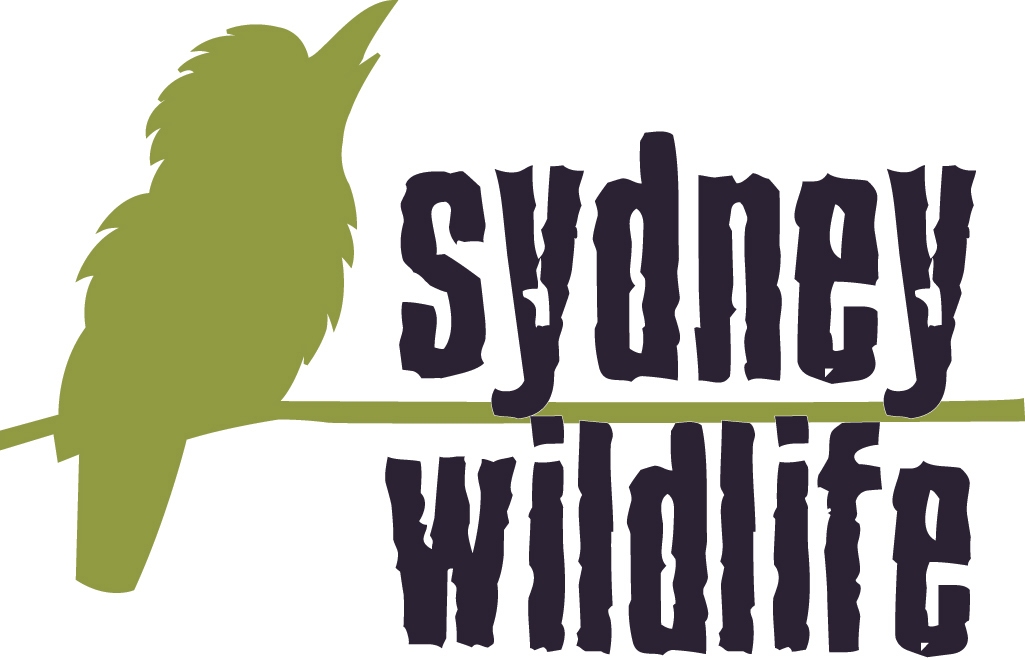
Friends Of Narrabeen Lagoon Catchment: Bushwalks 2020
Bushcare In Pittwater
Where we work Which day What time
Avalon
Angophora Reserve 3rd Sunday 8:30 - 11:30am
Avalon Dunes 1st Sunday 8:30 - 11:30am
Avalon Golf Course 2nd Wednesday 3 - 5:30pm
Careel Creek 4th Saturday 8:30 - 11:30am
Toongari Reserve 3rd Saturday 9 - 12noon (8 - 11am in summer)
Bangalley Headland 2nd Sunday 9 to 12noon
Bayview
Winnererremy Bay 4th Sunday 9 to 12noon
Bilgola
North Bilgola Beach 3rd Monday 9 - 12noon
Algona Reserve 1st Saturday 9 - 12noon
Plateau Park 1st Friday 8:30 - 11:30am
Church Point
Browns Bay Reserve 1st Tuesday 9 - 12noon
McCarrs Creek Reserve Contact Bushcare Officer To be confirmed
Clareville
Old Wharf Reserve 3rd Saturday 8 - 11am
Elanora
Kundibah Reserve 4th Sunday 8:30 - 11:30am
 Mona Vale
Mona Vale Mona Vale Beach Basin 1st Saturday 8 - 11am
Mona Vale Dunes 2nd Saturday +3rd Thursday 8:30 - 11:30am
Newport
Bungan Beach 4th Sunday 9 - 12noon
Crescent Reserve 3rd Sunday 9 - 12noon
North Newport Beach 4th Saturday 8:30 - 11:30am
Porter Reserve 2nd Saturday 8 - 11am
North Narrabeen
Irrawong Reserve 2nd Saturday 2 - 5pm
Palm Beach
North Palm Beach Dunes 3rd Saturday 9 - 12noon
Scotland Island
Catherine Park 2nd Sunday 10 - 12:30pm
Elizabeth Park 1st Saturday 9 - 12noon
Pathilda Reserve 3rd Saturday 9 - 12noon
Warriewood
Warriewood Wetlands 1st Sunday 8:30 - 11:30am
Whale Beach
Norma Park 1st Friday 9 - 12noon
Western Foreshores
Coopers Point, Elvina Bay 2nd Sunday 10 - 1pm
Rocky Point, Elvina Bay 1st Monday 9 - 12noon
Gardens And Environment Groups And Organisations In Pittwater
Pittwater Reserves
Planning Commission Asked To Decide Narrabri Gasfield Despite Major Flaws In Regulation And Knowledge
March 12, 2020
The Lock the Gate Alliance has condemned the referral of Santos’ Narrabri coal seam gas project to the Independent Planning Commission just days after a Parliamentary Inquiry found there was a severe lack of information and regulation related to the industry.
“The Commission will be stabbing in the dark when it tries to make a decision on this destructive, polluting proposal,” Lock the Gate NSW spokesperson Georgina Woods said.
“Major flaws in regulation and knowledge of coal seam gas were identified by a parliamentary committee two weeks ago, yet Planning Minister Rob Stokes has not listened and has referred this project anyway.”
The Minister’s referral, which was yesterday published on the Independent Planning Commission’s website, was made just three business days after the Parliamentary Inquiry found that five years on, only two of the Chief Scientist’s 16 recommendations on coal seam gas had been implemented.
The committee described the industry as “uninsurable” and last week Environment Minister Matt Kean told Budget Estimates he thought there should be no more coal seam gas drilling anywhere until the Chief Scientist’s recommendations had been implemented.
Ms Woods said the IPC would be making a decision in the dark and applying a regulatory scheme that has been exposed as being too weak to protect water resources and farmers from unforeseen damages.
“The Independent Planning Commission must comply with the Minister’s direction to determine this application, but it will be doing so with inadequate data, unfinished regulation and the results of a groundwater impact model that is incapable of predicting impacts on landholders’ bores at the local scale.
“An inquiry found just two weeks ago that NSW regulation of the coal seam gas industry is not up to the standard recommended by the Chief Scientist. The regulation was exposed as being too weak to protect water resources and farmers from unforeseen damages, leaving landholders to suffer under an industry labelled ‘uninsurable’.
“We don’t see how the Independent Planning Commission can approve the Narrabri coal seam gas project in this context. It’s untenable to leave landholders and local communities exposed to the lasting cost of depleted or contaminated groundwater, leaking methane, or leaching toxic salt dumps.
“If approved, the Narrabri CSG project would drill 850 gas wells right through a water recharge aquifer of the Great Artesian Basin, putting at risk precious groundwater that many rely on for food and fodder production.
“The Planning Minister has passed the buck and it is up to the Commission now to defend the public interest and stop this reckless gasfield.”
Commission Introduces New Guidelines For Public Hearings
March 10, 2020
The state’s Independent Planning Commission has made changes to how it will conduct its public hearings to ensure the process is more interactive, in response to the recommendations of the recent Productivity Commission Review of the Commission.
Public hearings into the carrying out of state significant development are held only at the request of the Minister for Planning and Public Spaces, as set out in the Environmental Planning & Assessment Act 1979. If a public hearing is held, merit appeal rights to the NSW Land and Environment Court in respect of any future determination made by the Commission as consent authority are extinguished for both the applicant and objectors. The Commission can also choose to conduct a public meeting as part of its decision-making process for other SSD applications, which does not affect merit appeal rights.
Under its revised ‘Public Hearing Guidelines’, the Commission hearings involve:
- the Chair of the appointed Commission Panel giving a brief opening statement, describing the Commission’s role in determining the development application;
- the Applicant providing a description of the proposed development;
- the Department of Planning, Industry & Environment presenting its whole-of-government assessment report and the rationale for its recommendation to the Commission that the proposed development be approved or refused;
- pre-registered members of the public presenting to the Panel.
The Commission may also elect to engage Counsel Assisting to ask questions or seek clarification from speakers at the hearing, as well as ensure procedural fairness is maintained throughout proceedings.
Once all registered speakers have presented to the Panel, the Chair will briefly adjourn the hearing to allow Commissioners time to consider what they have heard. After the adjournment, the Chair will provide a closing statement, which may include, at the Panel’s discretion:
- follow up questions being put to the Applicant or the Department, which can either be answered immediately or taken on notice;
- clarifying questions being put to scheduled speakers who are present – including, for example, in regard to their views on the Department’s assessment and/or recommended conditions;
- description of the next stages of the Panel’s deliberation process, including any meetings planned with stakeholders.
Notably, there will be no new Multi-Stage Public Hearings, which was a recommendation of the Productivity Commission’s Review of the Independent Planning Commission. However, the Vickery Extension Project is still subject to a Multi-Stage Public Hearing process and is due to return to the Commission shortly for the final hearing and determination.
Acting Chair of the Commission, Mr Peter Duncan AM, said the recent Review of the Commission has provided an opportunity to affect positive changes to the Commission’s processes.
“The Commission has done a lot of great work in the past few years to increase transparency, foster greater community participation and build trust in its decision-making processes for complex and contentious SSD applications,” Mr Duncan said.
“These changes to our public hearings will facilitate a more interactive process, where Commissioners can identify key issues or concerns and ask questions or seek clarification from the Applicant, Department or affected individuals or groups.
“They might get an answer then and there or their question might be taken on notice – either way, it is using the hearing process more effectively to get to the crux of key issues,” he said.
Mr Duncan noted the Commission will welcome feedback on the new process.
“We’re committed to continuous process improvement and will continue to engage with our stakeholders about our policies and procedures to seek their feedback on how we can do things better.”
EPA Seeks Public Input To Make Sure Polluters Pay For Their Clean-Up Costs
- hold or are applying for an environment protection licence issued under the Protection of the Environment Operations Act 1997 (POEO Act)
- are given a management order issued under the Contaminated Land Management Act 1997 (CLM Act)
- hold or are applying for a radiation management licence issued under the Radiation Control Act 1990 (RC Act)
- and the EPA requires you to provide a financial assurance for certain actions required by your licence or management order.
Community Input On The Future Of Plastics And Waste In NSW
- phase-out the use of plastics
- triple the proportion of plastic recycling by 2030
- reduce plastic litter items by 25% by 2025
- make NSW a leader in plastics research and development.
Indian Ocean Phenomenon Spells Climate Trouble For Australia
March 9, 2020: Australian National University
New international research has found a worrying change in the Indian Ocean's surface temperatures that puts southeast Australia on course for increasingly hot and dry conditions.
The work led by The Australian National University (ANU) and the ARC Centre of Excellence for Climate Extremes has a silver lining, helping to improve our understanding of climate variations and the management of risk caused by Indian Ocean variability.
Lead researcher Professor Nerilie Abram said the phenomenon her team studied, known as the Indian Ocean Dipole (IOD), was a big player in the severe drought and record hot temperatures last year.
"The 2019 event, known as a positive Indian Ocean Dipole, was a big one. It cut off one of the major sources for southern Australia's winter and spring rainfall, and set up the extremely hot and dry conditions for the terrible fires that ravaged Australia this summer," said Professor Abram from the Research School of Earth Sciences and the Centre of Excellence for Climate Extremes at ANU.
The new research published in Nature reveals that these historically rare events have become much more frequent and intense during the 20th Century, and this situation is expected to worsen if greenhouse gas emissions continue to rise.
The research team, which involved scientists from institutions in Australia, the United States, Indonesia, Taiwan and China, used coral records from the eastern equatorial Indian Ocean to reconstruct Indian Ocean Dipole variability over the last millennium with unprecedented precision.
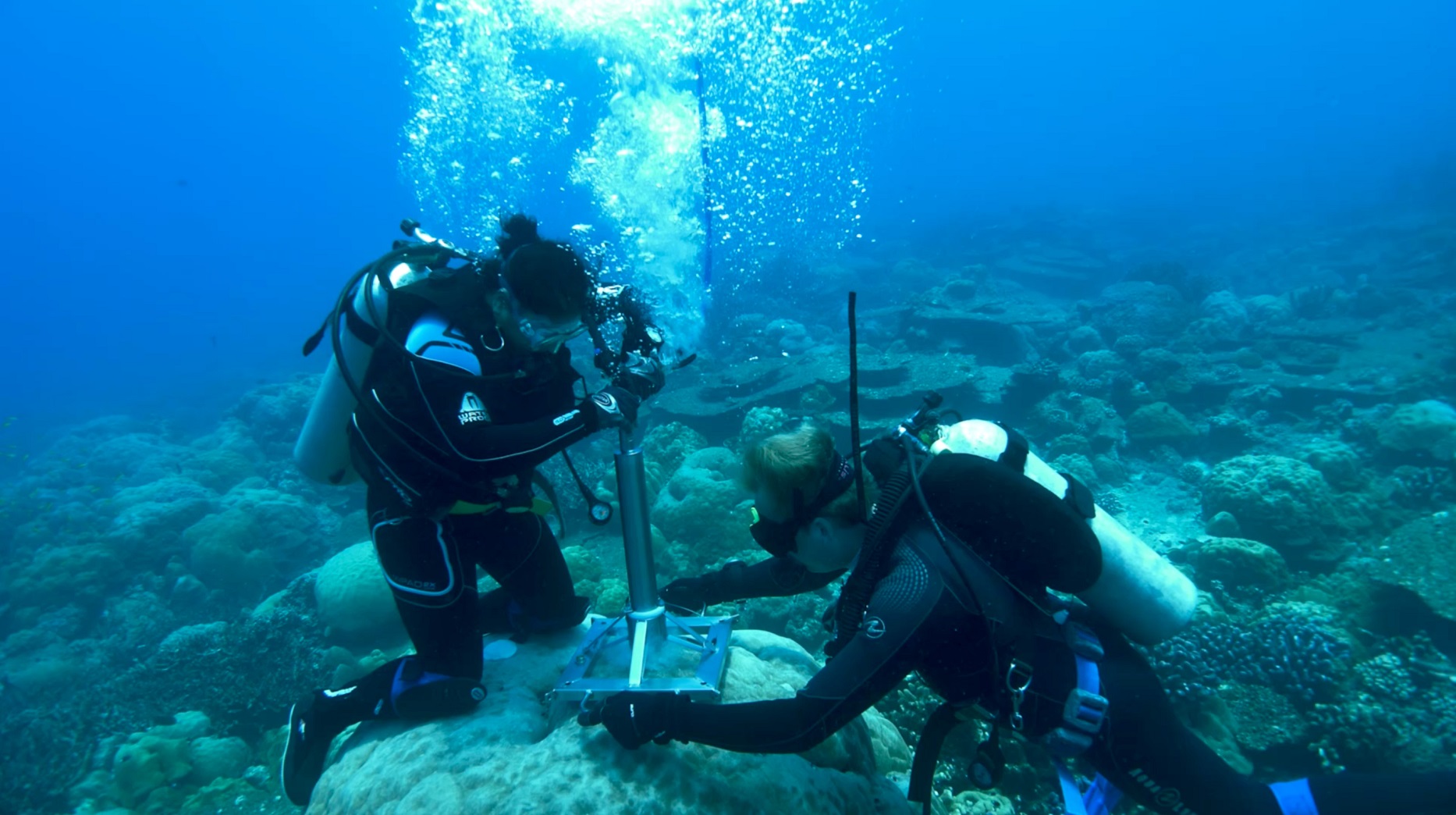
Underwater coral drilling start Image Credit: Jason Turl
"Historically, strong events like the one we saw in 2019 have been very rare. Over the reconstruction beginning in the year 1240, we see only 10 of these events, but four of those have occurred in just the last 60 years," Professor Abram said.
Co-researcher Dr Nicky Wright said the research highlighted that the Indian Ocean can harbour events that are even stronger than the extreme conditions seen in 2019.
"In 1675, an event occurred that was up to 42 per cent stronger than the strongest event we have observed so far during the instrumental record, which was in 1997. The terrible impacts of this older severe event can be seen in historical documents from Asia," said Dr Wright from the Research School of Earth Sciences and the Centre of Excellence for Climate Extremes at ANU.
"The 1675 event shows the type of extremes that are possible, even without human-caused climate change. By causing positive Indian Ocean Dipole events to become stronger and more common, we are now upping the odds that an extreme event like this one could happen again."
Co-researcher Professor Matthew England said the research also showed that a persistent, "tight coupling" has existed between the variability of the Indian Ocean Dipole and the El Niño-Southern Oscillation (ENSO) in the Pacific Ocean during the last millennium.
"Our research indicates that while Indian Ocean Dipole and El Niño events can occur independently, periods of large year-to-year swings in Indian Ocean variability also had heightened ENSO variability in the Pacific," said Professor England from the Climate Change Research Centre and the Centre of Excellence for Climate Extremes at the University of New South Wales.
"Looking at the tropical oceans in this interconnected way improves our understanding of seasonal to decadal climate variations in regions that profoundly impact Australia, helping us to be better prepared for future climate risks caused by the Indian Ocean Dipole."
Nerilie J. Abram, Nicky M. Wright, Bethany Ellis, Bronwyn C. Dixon, Jennifer B. Wurtzel, Matthew H. England, Caroline C. Ummenhofer, Belle Philibosian, Sri Yudawati Cahyarini, Tsai-Luen Yu, Chuan-Chou Shen, Hai Cheng, R. Lawrence Edwards, David Heslop. Coupling of Indo-Pacific climate variability over the last millennium. Nature, 2020; DOI: 10.1038/s41586-020-2084-4
Sea Turtles Have A Deadly Attraction To Stinky Plastic
March 9, 2020: Cell Press
Sea turtles around the world are threatened by marine plastic debris, mostly through ingestion and entanglement. Now, researchers reporting in the journal Current Biology on March 9 have new evidence to explain why all that plastic is so dangerous for the turtles: they mistake the scent of stinky plastic for food.
"We found that loggerhead sea turtles respond to odors from biofouled plastics in the same way they respond to food odorants, suggesting that turtles may be attracted to plastic debris not only by the way it looks, but by the way it smells," says Joseph Pfaller of the University of Florida, Gainesville. "This 'olfactory trap' might help explain why sea turtles ingest and become entangled in plastic so frequently."
Biofouling refers to the accumulation of microbes, algae, plants, and small animals on wet surfaces, which occurs to plastics in the ocean.
It has long been thought that sea turtles see plastics and visually mistake them for prey, such as jellyfish. But Pfaller and colleagues realized that little was known about the sensory mechanisms that might attract sea turtles to plastic.
In addition, study co-author Matt Savoca of Stanford University's Hopkins Marine Station had shown that airborne odorants used by marine predators to locate good places to find food also emanate from marine-conditioned or biofouled plastic debris. So, they asked, what could that mean for sea turtles?
To find out, the researchers enlisted 15 young, captive-reared loggerhead turtles. They delivered a series of airborne odorants through a pipe in an experimental arena and recorded their reactions on video. The odours they tested included deionized water and clean plastic as controls along with the turtle's food, which contains fish and shrimp meal and biofouled plastic.
The behavioral studies found that sea turtles responded to biofouled plastic in the same way they responded to their food. Compared to control odors, the turtles kept their nares out of the water more than three times longer to get a good whiff.
"We were surprised that turtles responded to odors from biofouled plastic with the same intensity as their food," Pfaller said. "We expected them to respond to both to a greater extent than the control treatments, but the turtles know the smell of their food since they've been smelling and eating it in captivity for 5 months. I expected their responses to food to be stronger."
He says future studies are needed to better understand what chemicals were emitted from the plastics to pique the turtles' interest and how waterborne odorants might come into play. But the new findings show that plastics of all kinds will present problems for sea turtles and other marine animals.
"The plastic problem in the ocean is more complex than plastic bags that look like jellyfish or the errant straw stuck in a turtle's nose," Pfaller said. "These are important and troubling pieces to the puzzle, and all plastics pose dangers to turtles."
Joseph B. Pfaller, Kayla M. Goforth, Michael A. Gil, Matthew S. Savoca, Kenneth J. Lohmann. Odours from marine plastic debris elicit foraging behaviour in sea turtles. Current Biology, 2020; 30 (5): R213 DOI: 10.1016/j.cub.2020.01.071
Looking After Warrumbungles Brush-Tailed Rock-Wallabies
March 12, 2020
NSW’s most westerly population of the endangered brush-tailed rock-wallaby, in Warrumbungle National Park will be further protected by a pest control program kicking off next week.
Senior Project Officer with the NSW National Parks and Wildlife Service Adam Fawcett said the aerial baiting program is part of ongoing management efforts to reduce the impacts of foxes on brush-tailed rock-wallabies as part of the Saving our Species (SoS) program.
"Looking after the brush-tailed rock-wallaby population in the Warrumbungles has been ongoing for more than 20 years.
“While not impacted during the recent fires which hit other colonies across the state, the Warrumbungle population was heavily impacted by the Wambelong Fire in 2013.
“Monitoring conducted over the past 12 months using camera trap images has identified approximately 12 brush-tailed rock-wallabies across the two remaining colonies, including females with pouch young.
“This number gives us an idea of the minimum population and is considered to be an underestimate of the actual number of animals remaining, but shows why it’s incredibly important we do all that we can to protect the colonies.
"Aerial baiting is being used to reduce the populations of red foxes within the landscape, minimising one of the key threats to rock-wallabies.
“Aerial baiting was introduced in 2018 to allow NPWS to target a broader area of the park around the remaining Brush-tailed Rock-wallaby colonies including areas that are difficult to access due to the mountainous terrain.
“Fox predation poses a serious threat to the survival of numerous other local native animal species and the benefits of fox control also extends across tenure to neighboring properties and farms.
“This work compliments targeted pest programs that have been implemented across the park to protect brush-tailed rock-wallaby colonies for several years. These include targeting feral goats competing for shelter and food.
“The aerial baiting program is being targeted within the northern parts of Warrumbungle National Park around and between the extant colonies of the brush-tailed rock-wallaby. The program is being undertaken in consultation with Central West Local Land Service and is expected to occur every 6 to 8 weeks from March through until early November,” Mr Fawcett said.
The Saving our Species program is the NSW Government's commitment to securing the future of the State's threatened plants and animals. To find out more, or to get involved with Saving our Species visit Help save our threatened species.
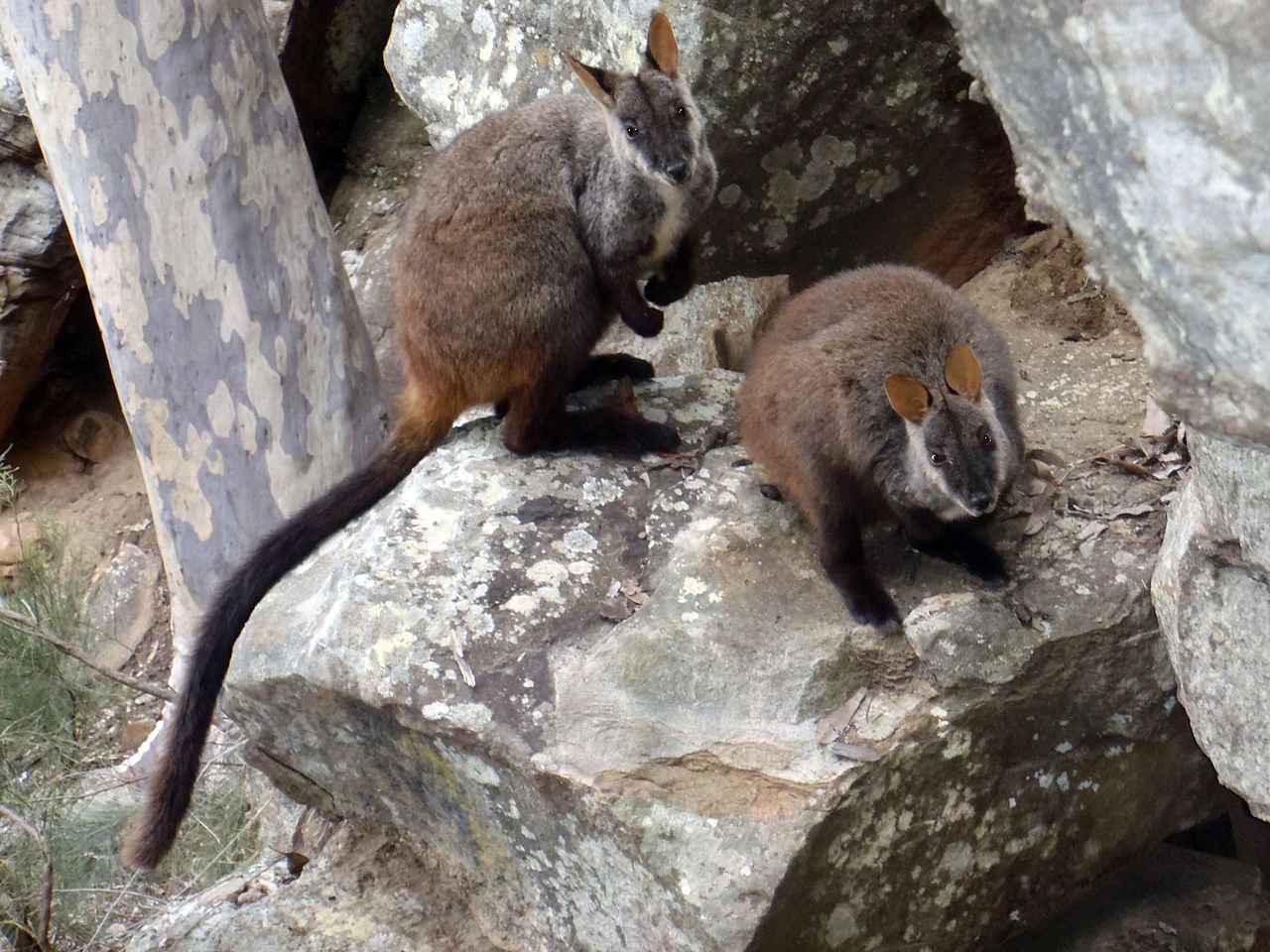
Brush-tailed Rock-wallabies in the Watagan Mountains on the NSW Central Coast. Photo Courtesy of Mark Hodgins
Gwydir Wetlands To Open To Birdwatchers
March 11, 2020
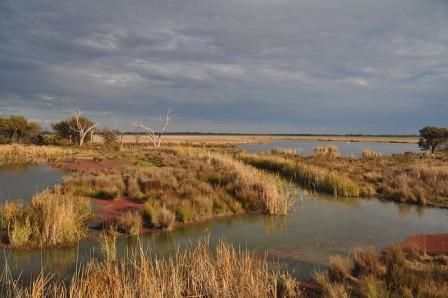 The National Parks and Wildlife Service is pleased to announce the reopening of the ‘Waterbird Lagoon’ at the Gwydir Wetlands State Conservation Area, near Moree.
The National Parks and Wildlife Service is pleased to announce the reopening of the ‘Waterbird Lagoon’ at the Gwydir Wetlands State Conservation Area, near Moree.
National Parks and Wildlife Service (NPWS) Area Manager Martin Linehan said the lagoon will be open to the public from Monday 9 March to Sunday 31 May and can be accessed via the Watercourse Road, about 60 kilometres west of Moree.
‘While the wetlands were directly impacted by fire in September last year, they have benefitted greatly from recent rainfall’” he said.
‘Our monitoring has found that birdlife, in particular, has rebounded spectacularly.
‘The Bunnor Bird Hide, situated next to the Waterbird Lagoon, provides a great vantage point to spot waterbirds such as egrets, spoonbills, ibis, stilts, and ducks, including pink-eared ducks and, if you’re lucky, you may even spot the threatened freckled duck.
‘You can either stay dry in the bird hide, bring a kayak, or come prepared to wade in the lagoon.’
Since records began in the 1920s, at least 75 waterbird species have been recorded in the Gwydir Wetlands, including colonies of straw-necked ibis, intermediate egrets, glossy ibis and nankeen night-herons.
Access is available from dawn to dusk during dry weather. No overnight camping is permitted in the state conservation area; however, there are facilities close by that can be booked at a local property called Boyanga South.
People wanting to visit these, or any other national parks, should check the NPWS website for the latest updates.
The Moree Tourism office also provides information on road conditions, local birdlife and the Gwydir Wetlands. Visit the office or their website
NSW To Host The International Shellfish Restoration Conference
The world’s foremost shellfish restoration experts and scientists will converge on Port Stephens this month (17th – 20th March 2020) for the 20th International conference, NSW Department of Primary Industries (NSW DPI) Senior Fisheries Manager, Kylie Russell, said today (March 4, 2020).
NSW Department of Primary Industries staff will host international experts from the USA, UK, Europe and New Zealand for the four day conference.
“Local specialists from Port Stephens and Australia, will delve deep into a wide range of topics related to shellfish reef restoration, at the home of NSW’s first large-scale oyster reef restoration project, within the Port Stephens-Great Lakes Marine Park,” Ms Russell said.
“Shellfish reefs are one the most impacted marine ecosystems in the world. It has been estimated that 85 per cent have been lost globally and as much as 99 per cent impacted in Australia.
“Shellfish restoration efforts and research are growing globally each year to restore and rebuild these important habitats and the many ecosystem services they provide to coastal communities.
“We will discuss project planning and monitoring, the latest research, restoration in a changing climate, maximising ecosystem services, innovation in restoration, working with local communities, collaboration and partnerships, biosecurity and several more relevant topics.“
Ms Russell said the conference will provide an exciting opportunity to progress the science and practice of shellfish reef restoration by providing a forum to share ideas, experiences and advances from leaders in diverse fields from around the globe in a truly spectacular location.
“The International Conference on Shellfish Restoration 2020 will take place within the traditional lands of the Worimi people on the shores of the magnificent Port Stephens-Great Lakes Marine Park. The Marine Park is extremely unique as it’s home to an extensive and diverse array of marine habitats which delegates will have the opportunity to view and engage with during the field trip component of the conference,” Ms Russell said.
To view the full program, register for the conference or to find out more, please visit the conference website.
The NSW Oyster Reef Restoration Project is a key action being delivered under the NSW Government’s Marine Estate Management Strategy (2018-2028).
Platinum sponsors of the conference are the Fisheries Research Development Corporation, the South Australian Government's Department for Environment and Water, and The Nature Conservancy. Support is also provided by Hunter Local Land Services, Port Stephens Council and the Sydney Institute of Marine Science.
Marine Estate Benefits From Aboriginal Knowledge And Expertise: Jobs And Training Boost Aboriginal Participation
March 4, 2020
Projects including Aboriginal people in care for Sea Country have resulted in significant environmental and cultural benefits. Left to right: Paul Brown (DPI) and James Cook (Far South Coast Landcare) with Peter Moore, Martin Mason and Jason Davidson (Wagonga LALC). Photo credit: Ian Kerr.
A boost to training and job opportunities has resulted in a significant increase in Aboriginal people participating in the management of the marine estate up and down the NSW coast.
The NSW Government’s Marine Estate Management Strategy (2018-2028) provided funding for 150 vocational training opportunities and provided local employment for more than 20 Aboriginal people.
This has provided a unique opportunity for a valuable exchange of information. Training programs have provided Aboriginal people with skills, for example in boat handling, crewing on boats and wildlife monitoring while staff appointments ensure Aboriginal people are managing Sea Country and helping government agencies understand their cultural needs. These projects have resulted in significant environmental and cultural benefits.
Some of the achievements for projects led by Aboriginal people include:
- 2,000 native trees planted and weed control spraying in the Tilba Tilba Lake catchment area
- 9 tonnes of rubbish removed from Dowadee Island at Port Stephens restoring the natural beauty of the island and improving access for Worimi Elders and community to a significant cultural place
- 200, Year 5 primary school students from the south coast participated in a Sea Country cultural education workshops
- nesting sites of migrating shorebirds monitored and protected at Wallaga Lake north of Bermagui
- nearly 100 Aboriginal graduates to receive their general boat licence
- over 30 Aboriginal graduates to receive their deckhand certificate.
More Aboriginal projects and programs are being rolled out across the NSW coast under Initiative 4 of the Marine Estate Management Strategy.
Illegal Fishers Cop $63,000 In Fines After Operation Turbo Reef
March 12 2020
More than 6,251 marine invertebrates have been seized, 337 offences detected and $63,000 in fines issued in an operation designed to target illegal shellfish collection in the Sydney metropolitan region.
The issuing of fines has completed Operation Turbo Reef, an initiative of NSW Department of Primary Industries Fisheries Compliance Unit.
Acting Director Fisheries Compliance Brett Andrew said the operation is now in its seventh year and took place over the Australia Day long weekend.
“Many of the headlands of the Sydney region are Intertidal Protected Area (IPAs) or Aquatic Reserves,” he said.
“These areas are closed to the collecting of shellfish and invertebrates to protect marine life and conserve important habitat and nursery areas for marine species.”
“A new mobile squad has been established targeting compliance in these areas. These areas are highly valued by local communities for their biodiversity and as sites for education and research.”
He urged fishers to ensure they comply with fishing rules and regulations.
“Fishers are reminded that if they wish to collect invertebrates, they must ensure that they are doing so in an area that is open to collecting, pay the recreational fishing fee unless exempt, and stick to strict collection methods and bag and size limits,” he said.
Mr Andrew said knowing the rules and regulations is particularly important as consuming invertebrates from some Sydney waterways carries risk.
“Sydney Harbour is closed to the taking of shellfish due to elevated levels of dioxins that pose a health risk,” he said.
He said some of the alleged offences detected during Operation Turbo Reef involved serious violations of fisheries rules and regulations.
“A female from Lethbridge Park, who is already known to fisheries officers, was allegedly found in possession of 1,043 cockles taken from the closed waters of Kogarah Bay. It is alleged she committed two offences, with each carrying a maximum penalty of $22,000 or six months imprisonment,” he said.
“6,251 invertebrates including cockles, abalone, turban snails, lobster and octopus were seized during the operation. Fortunately the vast majority were returned to the water alive.”
Anyone with information on illegal activity is encouraged to call the Fishers Watch line on 1800 043 536 or Report illegal activity online.
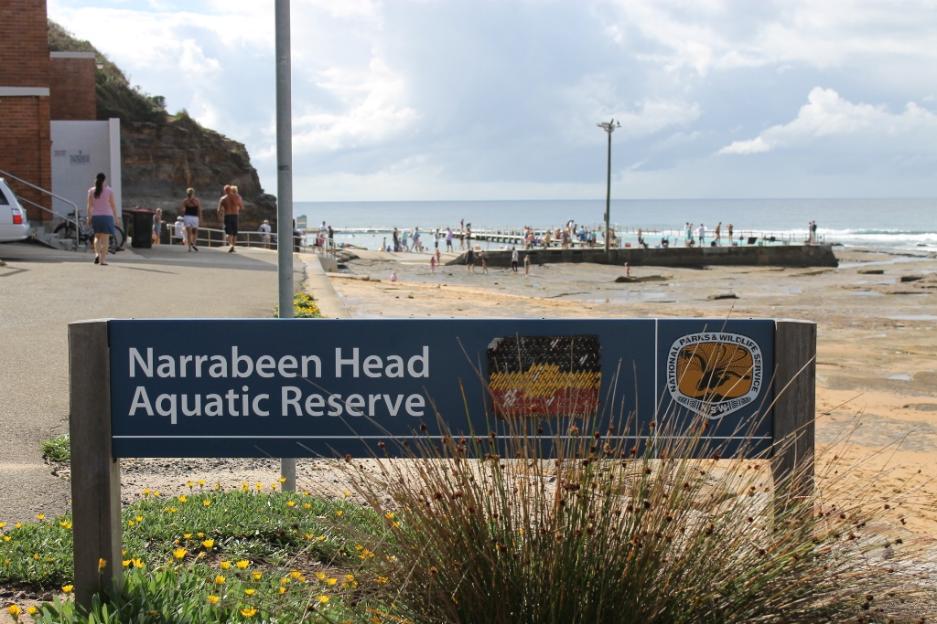
Ocean Plastic Returning To Aussie Coastlines
March 11, 2020
Plastic waste in the ocean is making its way back to land and increasing pollution on Australia’s beaches, according to new research from CSIRO, Australia’s national science agency.
It explains why estimates of waste entering the ocean each year are 100 times larger than the amount of plastic observed floating on the surface, and suggests waste management strategies on land need to accommodate larger volumes of pollution than previously estimated.
Dr Denise Hardesty is a Principal Research Scientist with CSIRO, working to solve the plastic pollution crisis by reducing unmanaged plastic leaking into the environment.
“We collected data on the amount and location of plastic pollution every 100 kilometres around the entire coast of Australia between 2011 and 2016,” Dr Hardesty said.
“The highest concentrations of marine debris were found along the coastal backshores, where the vegetation begins.”
Arianna Olivelli from Utrecht University, who led the analysis, said these findings indicate that coasts are a major sink for marine debris, particularly for larger debris items.
“The debris recorded along the coasts was found to be a mix of littering and deposition from the ocean,” Ms Olivelli said.
“The results suggest that plastic is moving from urban areas into the ocean, and then being transported back onshore, and pushed onto land, where it remains.
“Onshore wind and waves, together with more densely populated areas, influences the amount and distribution of marine debris. The further back we went from the water’s edge, the more debris we found.”
Wave activity has a much stronger effect than wind in determining where debris ends up.
These findings highlight the importance of including the entire width of coastal areas in studies to understand how much – and where – debris gets trapped.
This is critical for developing targeted waste management policies, particularly in areas with large regional populations, to reduce litter ending up in our oceans and along our coasts.
The study is published in Environmental Research Letters, available at Coastal margins and backshores represent a major sink for marine debris: insights from a continental-scale analysis
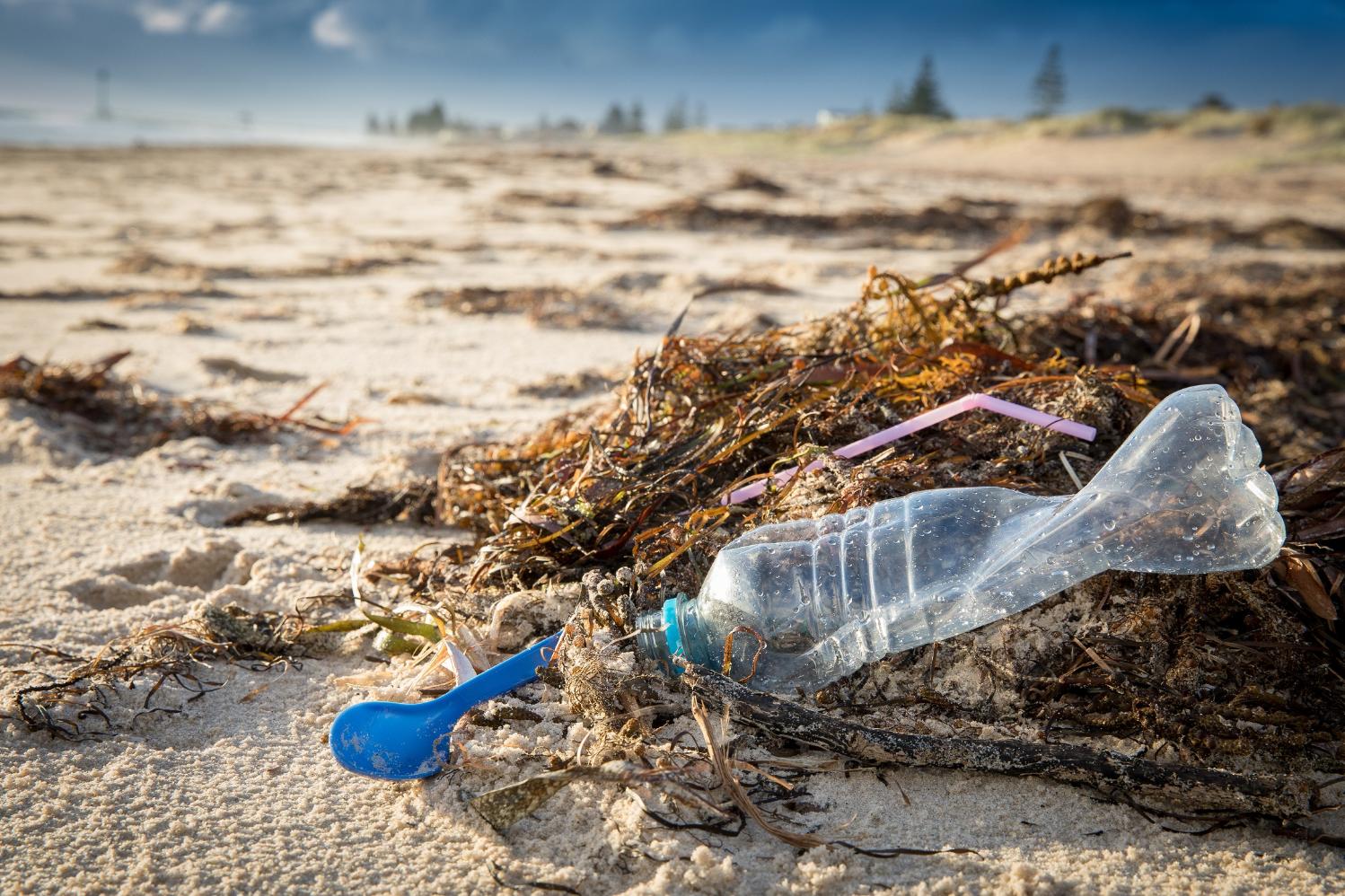
Entire Hillsides Of Trees Turned Brown This Summer. Is It The Start Of Ecosystem Collapse?
March 9, 2020
The drought in eastern Australia was a significant driver of this season’s unprecedented bushfires. But it also caused another, less well known environmental calamity this summer: entire hillsides of trees turned from green to brown.
We’ve observed extensive canopy dieback from southeast Queensland down to Canberra. Reports of more dead and dying trees from other regions across Australia are flowing in through the citizen science project, the Dead Tree Detective.
A few dead trees are not an unusual sight during a drought. But in some places, it is the first time in living memory so much canopy has died off.
Ecologists are now pondering the implications. There are warnings that some Australian tree species could disappear from large parts of their ranges as the climate changes. Could we be witnessing the start of ecosystem collapse?

Extensive canopy dieback in Kains Flat, NSW, January 2020. Matt Herbert
Why are canopies dying now?
Much of eastern Australia has been in drought since the start of 2017. While this drought is not yet as long as the Millennium Drought, it appears to be more intense. Many areas have received the lowest rainfall on record, including long periods of time with no rainfall. This has been coupled with above-average temperatures and extreme heatwaves.
The higher the temperature, the greater the moisture loss from leaves. This is usually good for a tree because it cools the canopy. But if there is not enough water in the soil, the increased water loss can push trees over a threshold, causing extensive leaf “scorching”, or browning. The extensive canopy dieback we have observed this summer suggests that the soil had finally become too dry for many trees.
Widespread rainfall deciciencies and higher temperatures across many parts of Australia. Bureau of Meteorology
Are the trees dead?
Brown or bare trees are not necessarily dead. Many eucalypts can lose all their leaves but resprout after rain.

Snowgums in the New England area resprouting in March 2020, following heavy rain. The trees lost most of their canopy during drought in 2019. Trevor Stace, University of New England
Many parts of eastern Australia are now flushed with green after rain. In these areas, it will be important to assess the extent of tree recovery. If trees are not showing signs of recovery after significant rainfall, they’re unlikely to survive. In some cases carbohydrate reserves – which trees need to resprout new leaves – may be too depleted for trees to recover.
The drought may also hinder post-fire recovery. Most eucalypt forests eventually recover from bushfires by resprouting new leaves. Some forests also recover when fire triggers seedlings to germinate.
But it’s likely that some forests now recovering from fire were already struggling with canopy dieback. So these two disturbances will test how resilient our forests are to back-to-back drought and bushfire.
Trees recovering from drought and/or fire may also enter the “dieback spiral”. The new flush of leaves following rain can make a particularly tasty meal for insects. Trees will then attempt to grow more foliage in response, but their ability to keep producing new leaves gradually declines as they deplete their carbohydrate reserves, and they can die.
Dieback spiral has led to extensive tree loss in the past, including in the New England area of NSW.
Should we be worried?
The capacity of eucalypts to resprout makes them naturally resilient to extended drought. There are some records of canopy dieback from severe droughts in the past, such as the Federation Drought. We assume (although we don’t know for sure) the forests recovered after these events. So they may bounce back after the current drought.
However, it’s hard not to be concerned. Climate change will bring increased drought, heatwaves and fires that could, over time, see extensive losses of trees across the landscape – as happened on the Monaro High Plain after the Millennium Drought.
Australian research in 2016 warned that due to climate change, the habitat of 90% of eucalypt species could decline and 16 species were expected to lose their home environments within 60 years.
Such a change would have huge consequences for how ecosystems function – reducing the capacity for ecosystem services such as carbon storage, altering catchment water resources and reducing habitat for native animals.
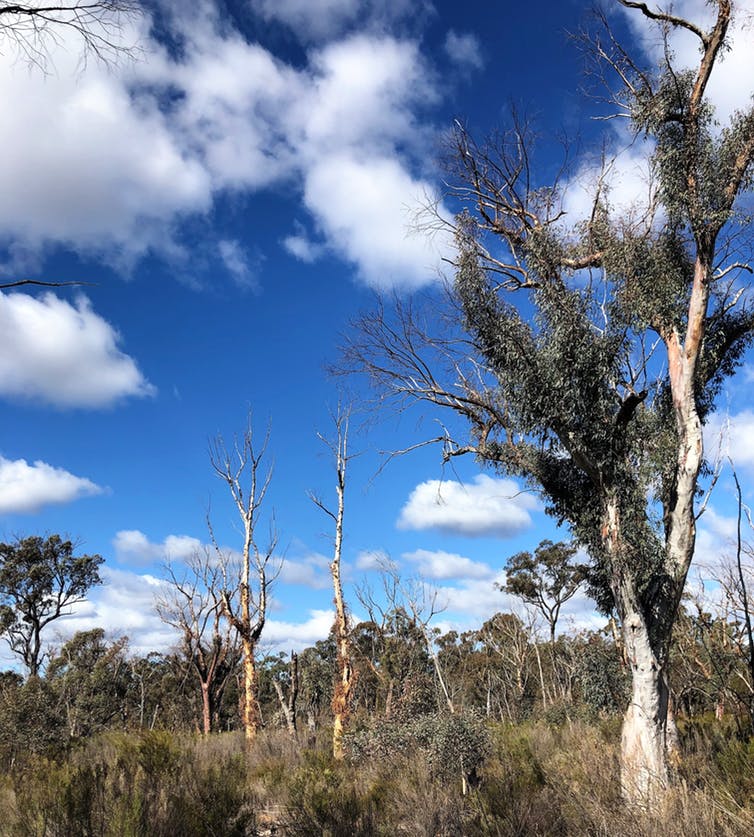
Some trees resprouted new leaves after losing their canopy. But in some cases these leaves are now dying, like on these scribbly gums in the NSW Pilliga in August 2019. Rachael Nolan
Where to from here?
Landholders can help bush on their property recover after drought, by protecting germinating seedlings from livestock and collecting local seed for later revegetation. Trees that appear dead should not be cut down as they may recover, and even if dead can provide valuable animal habitat.
Most importantly, however, we need to monitor trees carefully to see where they’ve died, and where they are recovering. A citizen science project, the Dead Tree Detective, is helping map the extent of tree die-off across Australia.
People send in photos of dead and dying trees - to date, over 267 records have been uploaded. These records can be used to target where to monitor forests during drought, including on-ground assessments of tree health and quantifying the physiological responses of trees to drought stress.
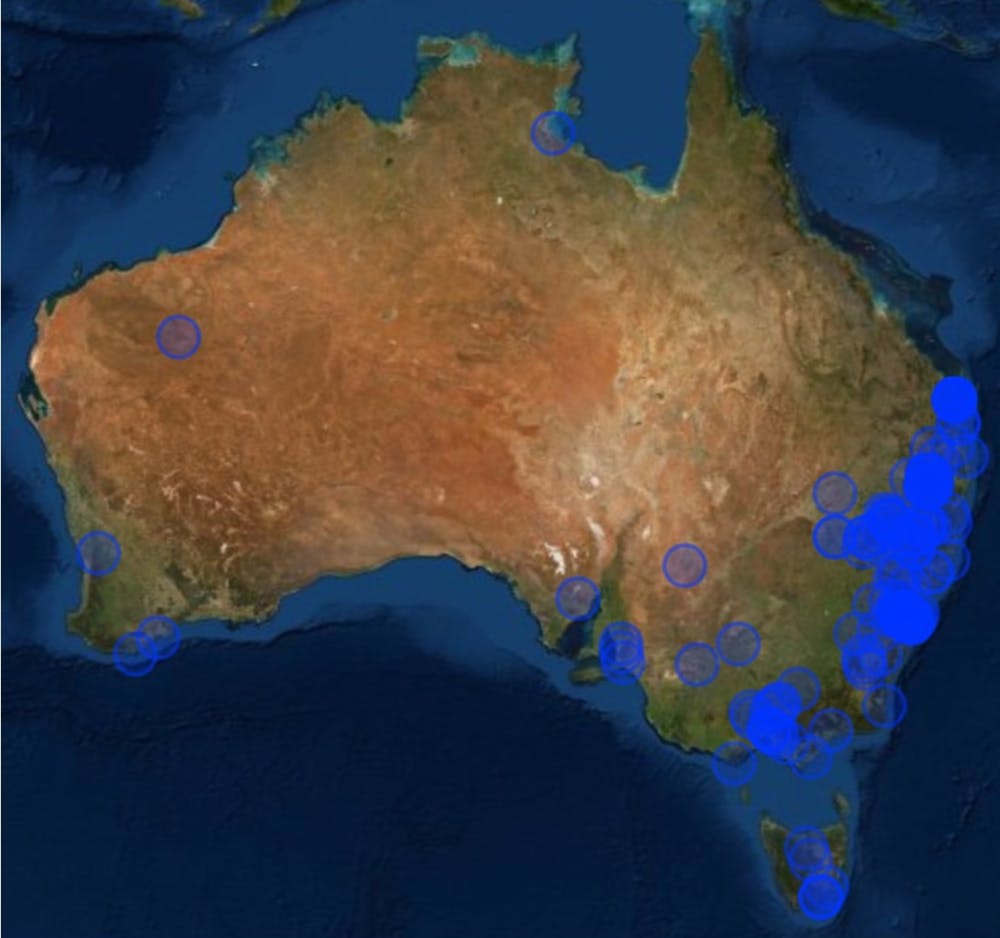
Records of dead and dying trees on the Dead Tree Detective map. Dead Tree Detective
There is no ongoing forest health monitoring program in Australia, so this dataset is invaluable in helping us determine exactly how vulnerable Australia’s forests are to the double whammy of severe drought and bushfires.
By Rachael Helene Nolan, Postdoctoral research fellow, Western Sydney University; Belinda Medlyn, Professor, Western Sydney University; Brendan Choat, Associate Professor, Western Sydney University and Rhiannon Smith, Research Fellow, University of New England.
This article was published first in The Conversation, visit here to rtead the original article. Republished under a Creative Commons licence.
Aussie Bread Tags Collection Points

NSW Schools Join National Action Against Bullying This Week: March 20
March 12, 2020: NSW Dept. of Education
Twelve NSW public schools will mark the 2020 National Day of Action Against Bullying and Violence by launching student-led anti-bullying projects.

Newington Public School student Emily Hirschhorn shares her team's anti-bullying plan at the Student Anti-bullying Summit.
The national day is a positive day of action to empower students and unite school communities to find workable solutions to address bullying and violence.
The 2020 National Day of Action Against Bullying and Violence (NDA) on 20 March has adopted the theme of "Take Action Together".
Last year 1,721 NSW schools and 708,922 students participated in the national day, an increase of 427 schools and 164,974 students on the previous year. Organisers are hoping for an even better response this year, the tenth year the NDA has been held.
As part of the 2020 NDA, the NSW anti-bullying website will launch 12 student-led anti-bullying projects from primary and secondary schools across the State.
All 12 projects were initiated as part of the Student Anti-bullying Summit held in Sydney late last year with schools represented across NSW.
The Georges Hall Public School project identified ways to solve bullying behaviour by participating in an online 'escape room', while Tarago Public School students created visual displays around the school to support students interacting in a positive way.
The project from Armidale Secondary College students revolved around "understanding and managing fear" while Bowral High School students "re-imagined the school's anti-bullying policy".
Following the 2020 NDA launch, all completed projects will be included on the NSW anti-bullying website for all schools to access.
Aurora College and eSafety are hosting a "virtual classroom" on 17 and 18 March to mark the 2020 NDA.
The theme for this virtual classroom is "Respectful Chat, I can do that!"
The virtual classrooms will see students in years 4 to 6 participate in a 40-minute video presentation with an eSafety expert exploring social and emotional skills for interacting online to build positive online relationships.
They will consider the emotions that appear when they or a friend is having a bad online experience as well as cyberbullying and strategies for seeking support for serious incidents.
For more information on the 2020 National Day of Action Against Bullying visit https://antibullying.nsw.gov.au/
New Street Library In Elanora Heights
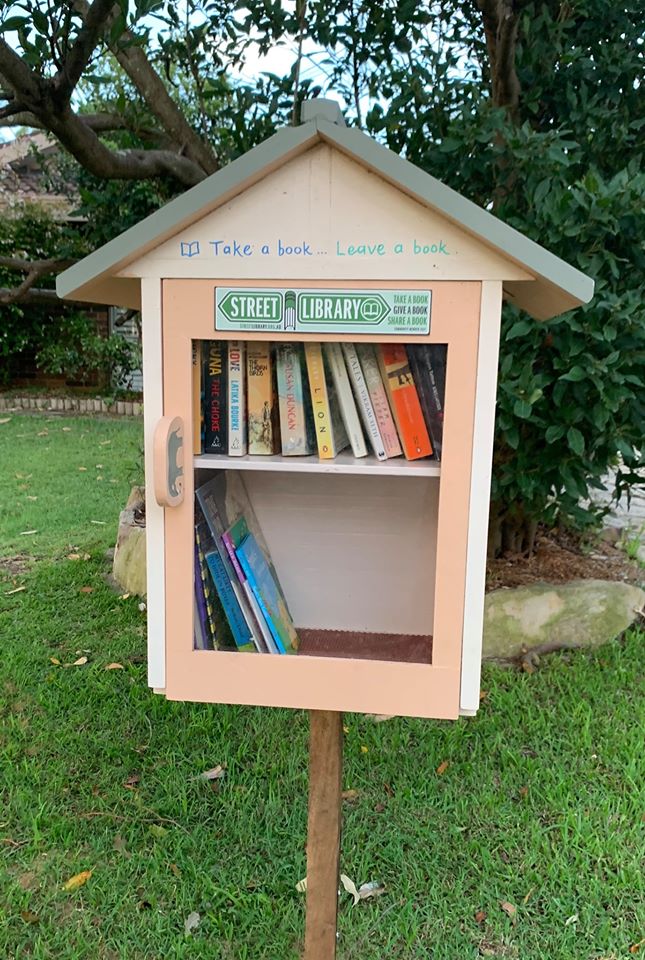
Pittwater Secondary Schools Teams Racing Regatta For The Pittwater Cup 2020
The RPAYC recently conducted the 2020 edition of the Pittwater Secondary Schools Teams Racing Regatta, with the winners crowned and honoured with the ‘Pittwater Cup’ Trophy.
In moderate to fresh southerly’s over both the twilight session on Friday 6th and the afternoon session on Saturday 7th March, a single round-robin was conducted prior to the 5th/6th sail-off, the semi-finals and finals.
After a full round-robin and not claiming a win during that stage, it was the Knox Grammar School lining up against the more favoured Pittwater High School 1 (Eagles) for the 5th v 6th Sail-off, in a first to two wins series. In race one and despite a Knox boat capsizing, the PHS1 team still couldn’t overcome Knox, who scored their first 1st & 2nd of the regatta. Knox then went on to claim their second win of the Regatta in Race two, to claim 5th place overall, with PHS 1 having to settle for 6th place overall in 2020.
Turning to the first Semi Final, it was the St Aloysius College vs the Pittwater High School 2 (Sharks). The St Aloysius Team had a clean slate of 1st and 2nd in each of their round-robin races and that strong form continued through both their Semi Final match ups with PHS 1, wiping them out with two further dominant performances with a 1st, 2nd & 3rd in both races.
In the other Semi Final it was the 2019 Champions the Mater Maria Catholic College vs the Pymble Ladies College. Within two races, Mater Maria wrapped up their birth in the Final, accounting for PLC with an equally dominant performance as the St Aloysius team, setting up a mouth-watering final, deferring PLC to fight it out in the Petite Final against PHS2.
Once the first race of the Petit Final got underway, it was clear that PLC would be favourites, with the PHS2 team slow off the mark and the PLC girls rocketing to the line in quick succession to score a 1st, 2nd and 3rd. Race two of the Petite Final was similar to the first, with the PHS2 team now running out of puff and stamina in the building southerly; PLC taking the second race with a 1st, 2nd and 3rd and claiming 3rd place overall in 2020.
As the Southerly breeze continued to build towards 20knts and with just the remaining two teams left to fight it out, the tension began to build. Where all the previous races were somewhat void of tactics and were more like sprint races, the Aloysius v Mater final will be remembered for lots of pre-start stalking manoeuvres, very close tactical racing, including capsizes, plus, masts crashing down mid race and ‘very’ close finishes at the line.
The Final certainly went the full distance of the three scheduled races, with race two having to be re-sailed after gear failure on the course. In race one, Mater quickly snapped up the chocolates scoring a 1st and 2nd, handing the Aloysius team their first loss of the Regatta, before the drama filled race two.
With plenty of the aforementioned pre-race tactics evident, race two was looking at coming down to the wire, with boats touching at the final mark and the umpires having to make quick decisions. Soon after on that same final leg, one of the better positioned Aloysius boats had a mast failure and the narrow finish meant that the result could have been affected by the gear failure. The Race Committee quickly decide that race two be re-run with Aloysius getting on top this time, to level the scores at one a piece, scoring a 1st and 2nd in race two.
In race three of the Final, all the tricks came out of the bag yet again for both teams, with the breeze still nudging close to 20kts. The start and the mark rounding’s were tight to begin with, but soon after, two Mater boats managed to get clear and streaked away. The Mater Maria team had obviously managed to hold their nerve after the furore in race two, to secure the final race and the title of Regatta Champions, with a well-earned 1st and 2nd in race three.
In summary, Mater Maria triumphed (for the second year running) over the St Aloysius College (2 wins to 1) in the Final, with the Pymble Ladies College knocking over the Pittwater High School Eagles for third place (2 wins to 0) in the Petite Final.
The Abbotsleigh Umpires Trophy was deservedly awarded to the St Aloysius College and RPAYC would like to thank Richard Hudson for offering his time as Umpire.
Final Placings
1st Mater Maria (Winner of the Pittwater Cup)
2nd St Aloysius College (Awarded the Abbotsleigh Umpires Trophy)
3rd Pymble Ladies College
4th Pittwater High School 2 (Sharks)
5th The Knox Grammar School
6th Pittwater High School 1 (Eagles)
The RPAYC as the Organising Authority, is already pencilling in dates for early March 2021 for next year’s regatta, giving teams plenty of opportunity to plan ahead. The schools are all looking forward to more racing at the upcoming events on Sydney Harbour as preparation for the State Championships at Georges River on the 1-3 May.
Find out more about the RPAYC School Sailing Training programs
Youth Week 2020
The theme for this year is:
Speak up. Be involved. Get connected. Have fun.
Youth Week began as a NSW Government initiative in 1989, and has since grown to be a celebration of young people in every state and territory across the country. In 2020 Youth Week runs from April 1-9.
It is organised by young people, for young people, in communities across NSW and Australia. Following the success of the NSW Youth Week program, Youth Week became a National event in 2000. National Youth Week is jointly supported by the Australian Government, State and Territory Governments and Local Governments.
NB: Following COVID-19 restricting gatherings by people the below events may be cancelled - we run them at this stages as they have not been cancelled as yet.
National Youth Week is an opportunity for young people to:
- share ideas
- attend live events
- have their voices heard on issues of concern to them
- showcase their talents
- celebrate their contribution to the community
- take part in competitions
- have fun!
Youth Week Fun Fair - Free
Wednesday, 1 April 2020 - 3:00pm to 6:00pm
Dunbar Park
59 Old Barrenjoey Rd
Avalon
Avalon Youth Hub are hosting a Youth Week Fun Fair to celebrate Youth Week. Come down and join us for FREE bubble soccer, ninja obstacle course and much much more!
Northern Composure Band Comp Final
Friday, 3 April 2020 - 7:00pm to 11:00pm
PCYC, Northern Beaches
40 Kingsway
Dee Why
Northern Composure band comp final is on!
Come and check out local bands battle it out to win their share of $10,000 in prize pool. This is an all ages gig. Drug and alcohol free. No pass outs.
Dungeons & Dragons Day - Free
Sunday, 5 April 2020 - 9:30am to 1:00pm
Mona Vale Library
1 Park Street
Mona Vale
Interested in role-playing games?
Pick up a sword, grab some dice, and prepare for an adventure! Whether you’re a veteran dragon-slayer or a first-time player, step into the shoes of a hero.
Prizes for best dressed! Play as your favourite character or just come as yourself, it’s up to you.
Ages 12 - 24
Refreshments and snacks provided. Bookings essential - Free
Youth Week Millennial Market
Sunday, 5 April 2020 - 10:00am to 2:00pm
Village Park
1 Park Street
Mona Vale
Council has organised a Millenial Market to be held at Mona Vale's Village Park. Made by under 25s for our community to celebrate youth on the Northern Beaches!
Under 25’s will be selling their recycled fashion and handmade goods. There will be free activities and workshops and live music to keep you entertained. Don’t forget to bring your reusable cup, water bottle and bags.
Market Stallholders
Only open to Northern Beaches residents under the age of 25. You cannot sell goods above $50 in value.
$20 (including booking fee) per stall - must be paid at time of booking.
There are no cancellation refunds however you can transfer your stall to a friend.
You must conduct your stall in line with Council's Event Waste Minimisation Guidelines and adhere to the Terms and Conditions. A confirmation email with a Stallholder Information Pack and tips will be sent to stallholders during the week prior to the event.
Musicians
We love to support local talent! We are seeking interest from music groups, bands, or buskers who would like to entertain shoppers on the day.
Expressions of interest are now open! Please complete an online expression of interest and send us a link or file to show us your music style. Please note - there is no access to power.
Youth Week Skate Jam - Free
Wednesday, 8 April 2020 - 4:30pm to 7:30pm
Mona Vale Skate Park
1604 Pittwater Road
Mona Vale
Avalon Youth Hub and Totem have partnered to run a non-competitive open ability and ages skate jam!
The jam style comp is a non-competitive session that gives skaters a chance to showcase their skills, push their own boundaries and skate together in a fun and safe environment.
Plus loads of prize giveaways!
Schedule
- 4:30 pm - 5:30 pm Beginner Jam
- 5:30 pm - 6:30 pm Intermediate Jam
- 6:30 pm - 7:30 pm Opens Skate Jam
FAQs
Q. How do I know which session to register for?
A. Our beginner session is designed for those that want to learn or get more comfortable with standing on a skateboard, pushing or riding around and turning their board. Our intermediate session is more focused towards those that are comfortable skating on a skateboard, want to learn some basic level tricks and practice going down ramps at the skatepark. We ask you to only register for the session that is suitable for your ability. That way the session is run to cater for everyone and nobody gets left behind.
Q. Is there a minimum or maximum age requirement to enter the event?
A. Yes, the participant must be 5 years old. And there is no maximum age.
Q. What do I need to bring to the event?
A. Your ticket, a hat and water bottle. We supply all necessary equipment for our sessions (skateboard, helmet and safety pads). However, feel free to bring along your own board or helmet so the coaches can do a quick safety check!
Q. Do I need to fill out a waiver form?
A. Yes, you need to complete a waiver form(Opens in a new window) before you can start skating in a workshop session. You must do so every time you register for an event.
Q. What do I do if I have registered and can't make it anymore?
A. If you have registered for an event and can't make it anymore, we ask that you cancel your ticket through Eventbrite. We often sell out and people are then put onto a wait list. If you cancel your ticket it means someone else can come to the event. If you are having difficulty cancelling your ticket please contact us at bookings@totemskateboarding.com
Q. What if it looks like rain?
A. If it looks like it's going to rain, you will be sent an event update email as soon as possible. Sorry, but we can't skate in the rain!
Bookings
Bookings are essential. Register now to get your ticket(Opens in a new window).
Don't forget to fill out the online waiver form(Opens in a new window) after you book your spot.
For any other questions or enquiries email us at bookings@totemskateboarding.com
Lifeline Classic 2020
Gen Z The Fastest Growing Victims Of Scams
10 March 2020: ScamWatch - Federal Australian Government
Australians under 25 lost over $5 million to scams in 2019 and reports made from this age group are increasing faster than older generations.
In 2019, around 12,000 (7.15 per cent) reports made to Scamwatch were from people under the age of 25, an increase of 11 per cent compared to 2018 figures. Reports from this age group increased by 10 percentage points more than any other age group.
“Scammers don’t discriminate based on age and the wide-range of scams reported by this age group is concerning,” ACCC Deputy Chair Delia Rickard said.
“Young people may think they are tech savvy, but scammers are adapting and we expect to see more scams on newer platforms such as Snapchat and TikTok.”
Facebook and Instagram were the most common platforms for reports and losses by those under 25, with typical scams on these platforms involving fake online stores or the sale of fake tickets to events.
Online shopping scams were the most common scams, making up more than 14 per cent of reports and almost 12 per cent of losses among people under 25.
“Almost half of the losses to people under 25 occurred through bank transfer but you should also be wary of sellers asking for payment through unusual payment methods such as gift cards or bitcoin,” Ms Rickard said.
“Always try to purchase tickets from authorised sellers and be aware that many links sourced through social media will not be legitimate.”
Additionally, scammers are using social media platforms and email as forums for sextortion scams, where they threaten to share intimate images or footage of you online, unless you give in to their demands.
“In many cases if you receive a sextortion threat from a stranger claiming they have compromising images or video footage of you, these images don’t actually exist, so delete the message. If you are concerned, you can contact the e-Safety Commissioner,” Ms Rickard said.
Scammers can also target children who play online video games, such as Fortnite, by offering unlocked achievements or special items in exchange for money or gift card codes without ever transferring the item.
“By targeting children, scammers could obtain personal and banking information from the individual’s parents,” Ms Rickard said.
“We encourage parents and guardians to ensure children do not share personal or banking details online, and if they think a scammer has gained access to their personal information contact their financial institution as soon as possible.”
“You should also contact the platform on which you were scammed and inform them of the circumstances surrounding the scam,” Ms Rickard said.
People can also report a scam to the ACCC through Scamwatch, which offers further information on where to get help, and how to protect yourself from scams.
Background
How to report scams on digital platforms:
To report a post, Facebook advises users to click on the top right of the post, and then select either ‘Report post’ or ‘Report photo’. They then have to select the option that best describes the scam, and follow the rest of the onscreen instructions.
To report a profile, Facebook suggests that a user clicks and selects ‘Report’ on the bottom right of the suspicious profile’s cover photo, and then follow the instructions onscreen.
To report a post, Instagram advises users to tap the three dots above the post, and select ‘Report’. Select the option that best describes the post and follow the onscreen instructions.
To report a profile, Instagram advises users to tap on the three dots in the top right of the profile and select ‘Report’. Select the option that best describes the profile and follow the onscreen instructions.
Snapchat
Users can report another account by pressing and holding that Snapchatter’s name, tapping ‘More’, then tapping ‘Report’.
To report a snap or story on the platform, users can press and hold on the snap or story until the white flag icon appears. They can then select this icon to Report to Snapchat.
TikTok
To report a suspicious account, users can click on said profile, tap the ‘Settings’ icon, tap ‘Report’, then follow the prompts.
To report a video, the user can open the video and tap the ‘Share’ icon, then tap ‘Report’ and follow the prompts.
To report a comment, the user can tap the comment that they’d like to report, click ‘Report’ and follow the prompts.
To report a message received, a user can open the conversation and tap the ‘Share’ icon, then tap ‘Report’ and follow the steps in the app.
All The World’s A Stage - Buskers Can Make It Big In A Connected World
March 9, 2020
by Daniel Bacchieri, PhD Candidate, Sir Zelman Cowen School of Music, Monash University
Street musicians are the producers of sidewalk melodies, the authors of the soundtrack of our cities. There is a unique interrelation between buskers and fans that occurs only in the streets, with no security staff, no VIP seats, or entrance fee.
In the past two decades, the audience for street performers has grown from dozens to millions thanks to sharing on social media like Facebook, Twitter and TikTok, digital platforms such as YouTube and Soundcloud, and streaming services including Spotify.
Busking has long been a way for musicians to gain performance experience and garner a following. Now digital platforms are powerful tools that can transmit local artists to global audiences.
From the streets to the charts
Australian singer Tones and I became a phenomenon after being discovered on the streets of Byron Bay. Since releasing Dance Monkey in May 2019, she went from being an unknown busker to become one of the most streamed artists on Spotify, with over 1 billion streams globally.
Four years ago, another global success was forged on the streets of Australia. Multi-instrumentalist Tash Sultana used to busk on Bourke Street in Melbourne. Then the live bedroom recording of her singing Jungle scored more than 64 millions views on YouTube.
Both acts share the same management company. Lemon Tree Music was founded in 2013 by two ex-buskers, Regan Lethbridge and David Morgan. Lethbridge told The Industry Observer that he hoped to tap into the drive shown by street performers to realise a vision of busking entrepreneurship:
We always respected buskers. […] We love the work ethic, the grind. They want it more. It’s the extra 1%. They have the drive to get out there on the street every day to earn some coins and sell some CDs.
Some of contemporary music’s biggest names were discovered on the streets: Ed Sheeran (performed in London underground stations), Justin Bieber used to busk in Stratford, Canada, and singer-songwriter Benjamin Clementine was discovered while singing at Paris metro stations.
These success stories connect with pre-internet idols: Édith Piaf, B.B. King, Janis Joplin and Rod Stewart all played on the streets. According to the late Blues writer Paul Oliver,
there have been street musicians since streets were first built, and human beings began to sing, or to make and play the first musical instruments.
After 37 years performing as a busker in New York, singer Mike Yung got a couple of his performances shared on YouTube. In 2018, Yung recorded a song with Dutch DJ Martin Garrix and scored more than 27 million views online.
Change for good
Some projects and platforms have sought to combine technology with busking for a cause.
Created in 2002, the Playing For Change project aims to record musicians in the streets with a mobile studio. Music producer Mark Johnson started by recording buskers all around the world singing lines from the song Stand By Me. The clip has now had more than 140 million views. Buskers from 125 countries took part, money was raised for music schools, and the concept became a global movement “to inspire and connect the world through music”.
The Busking Project is a platform where people can join as a busker or as a fan. Artists can be hired for events and earn cashless tips.
Similar payment tools and initiatives have been established in London, Austin (USA), Melbourne and São Paulo.
A cluster of buskers
Based on online map tags, the global busking festival scene is estimated to include over 170 street music events. There is the nine-day Ferrara Buskers Festival in Italy, the Edinburgh Festival Fringe in Scotland, and Fête de La Musique in France. HONK! is an independent and non-commercial festival of activist street bands created in Somerville, Massachusetts, USA, and Buskers by the Lake (formerly Buskers by the Creek) on Australia’s Sunshine Coast lists Tones and I among its previous busking battle winners.
In a world where everybody is filming, the streets are the backdrop to an international music video festival.
Curation projects like The Music Man, SoundsLikeVanSpirit and StreetMusicMap (featuring my research) identify busking hubs such as the subway systems and public squares in NYC, London and Paris and musicians performing along main streets like the Paulista Avenue in São Paulo (Brazil), Istiklal Street in Istanbul (Turkey) or Bourke Street in Melbourne, Australia.
Once mapped, we hope street music acts will illuminate narratives that go beyond sounds and beats. They will tell us about global culture and human connections.
This article was published first in The Conversation, click here to read the original. Republished under a Creative Commons licence.
Graphic novels help teens learn about racism, climate change and social justice – here's a reading list

Teen activists worldwide are making headlines for their social justice advocacy on everything from climate change and immigration to substance abuse and LGBTQ issues. As young people get more vocal about these issues, this trend is being reflected in the graphic novels they are reading.
It’s a relatively new genre. The term graphic novel first came about when cartoonist Will Eisner used the phrase to get publishers to recognize his 1978 work, “A Contract with God: And Other Tenement Stories,” as a novel rather than a comic book. Later, to help others understand the term he coined the definition: “a long comic book that would need a bookmark.”
Later, the cartoonist Art Spiegelman created “Maus,” which relayed his father’s experiences during the Holocaust through pictures in which Jews were mice, Germans were cats and Poles were pigs. The book became the first Pulitzer Prize-winning graphic novel in 1992. It was a game-changer, giving credibility to a format that many people, and even Congress, had previously criticized.
Sales have soared since then.
Because the combination of text and images in graphic novels can communicate issues and emotions that words alone often cannot, more educators and parents are finding them to be effective tools for tackling tough issues with kids. The acclaimed author Nikki Giovanni has put it this way. “A comic book is no longer something to laugh with but something to learn from.”
We are library and information science professors in the U.S. and Australia who are curating a collection of these books to share with educators, parents and students. Here are some highlights, grouped by category.
Racism And Other Forms Of Bigotry
In the graphic novel memoir “They Called Us Enemy,” actor, activist and Star Trek legend George Takei partnered with co-authors Justin Eisinger and Steven Scott and the illustrator Harmony Becker to share his family’s experience during World War II. During this time, U.S. citizens like Takei’s Japanese American family were forcibly moved to internment camps and treated like criminals. Takei encourages readers to give their voices to those who are silenced so that history does not repeat itself.
Another good example in this vein is “New Kid” by African American author and illustrator Jerry Craft. Its main character, Jordan, attends a private school where he is one of the few students of color. Jordan feels like a fish out of water, struggling to fit in at school and his neighborhood. New Kid" recently won the Newbery Medal – the first time that a graphic novel has won the prestigious U.S. children’s literary award.

Addiction And Mental Illness
Jarrett Krosoczka, the author and illustrator of “Hey Kiddo! How I Lost My Mother, Found My Father, and Dealt with Family Addiction,” makes his dysfunctional childhood as normal as possible by expressing himself through drawing. His powerful graphic memoir can help spark discussions about challenging issues with teens.
Another author and illustrator who drew her own path is Katie Green. With stark black-and-white illustrations, she presents the story of her struggle and recovery from eating disorders in “Lighter Than My Shadow.” A scribbly black cloud in the book represents Green’s disorders and the anguish that came with them.
Climate Change
The graphic anthology “Wild Ocean: Sharks, Whales, Rays, and Other Endangered Sea Creatures” explores the plight and beauty of endangered animals. Overfishing, global warming and other man-made dangers threaten the lives of these sea creatures. This eco-themed book, edited by comic artist and author Matt Dembicki, helps students connect with climate change issues. Reading the book may motivate them to develop ideas to help save our seas.
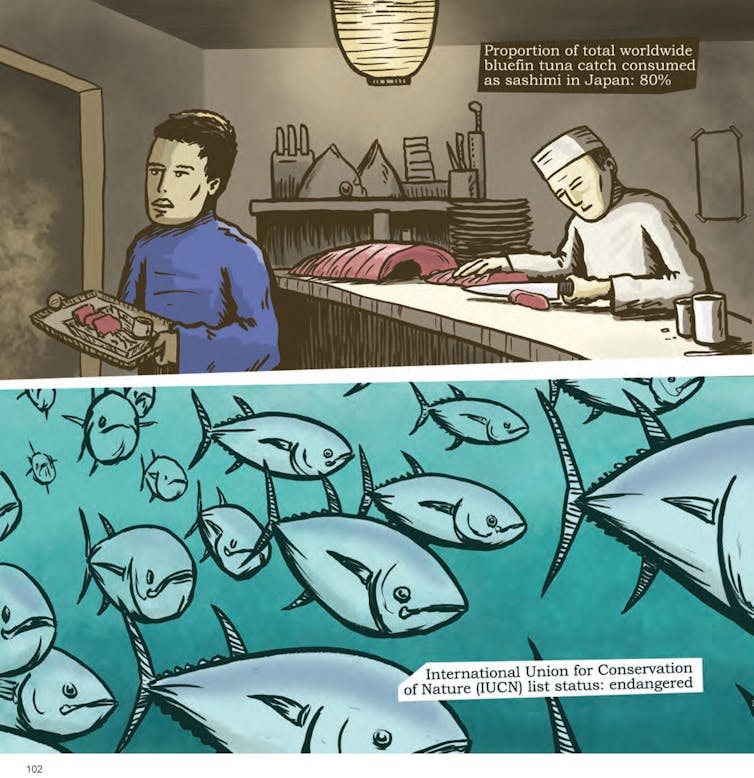
Immigration And Refugees
As the number of worldwide refugees increases, so has the number of graphic novels about them.
“Escaping Wars and Waves: Encounters with Syrian Refugees,” by the visual journalist Olivier Kugler, “Escape from Syria,” by foreign correspondent Samya Kullab together with illustrator Jackie Roche, and “The Unwanted: Stories of the Syrian Refugees” by author and illustrator Don Brown“ are powerful stories about Syrians forced to leave their homes and families. Their stories of the refugees’ struggles paint a stark picture of a problem that today’s young people may well have to fix in the decades ahead.
LGBTQ Teens
LGBTQ and intersex teens often feel isolated, confused and afraid while coming to terms with their sexual orientation and gender identity. Reading graphic novels with characters like themselves can help them understand it is OK to be who they are. Likewise, putting a book with these characters in the hands of non-LGBTQ teens can help them empathize with LGBTQ friends.
”Bloom,“ by writer Kevin Panetta and illustrator Savanna Ganucheau, is a graphic novel about Ari, a recent high school graduate. He feels pressured to work in the family bakery rather than following a musical career. When Ari hires a young man as his replacement, love is in the air and ready to bloom.
[You’re smart and curious about the world. So are The Conversation’s authors and editors. You can read us daily by subscribing to our newsletter.]![]()
Karen W. Gavigan, Professor of Library and Information Science, University of South Carolina and Kasey Garrison, Senior lecturer, Charles Sturt University
This article is republished from The Conversation under a Creative Commons license. Read the original article.
Natural Contaminant Threat To Drinking Water From Groundwater
Australian Tiny Homes: Free Webinar
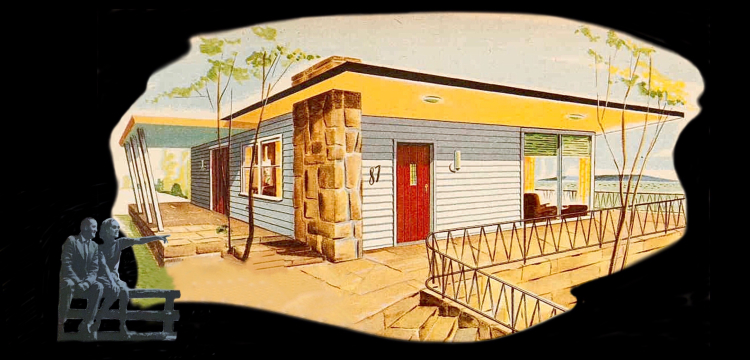
Building Blocks For Life On Earth Got Here Much Later Than We Thought Billion-Year-Old Rocks Show
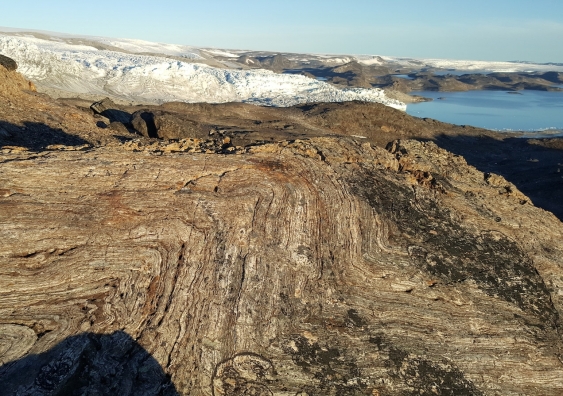
From Darkness To Light: New Findings Unravel How Plants Control Energy Generation
Engineers Crack 58-Year-Old Puzzle On Way To Quantum Breakthrough

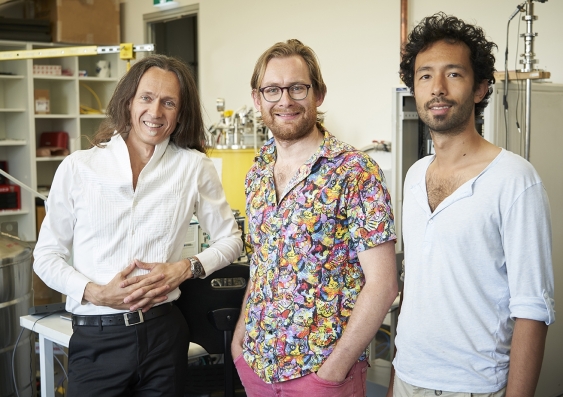
Dinosaur Stomping Ground In Scotland Reveals Thriving Middle Jurassic Ecosystem
UNSW Hydrogen Storage Technology In World-First Application Of Its Kind
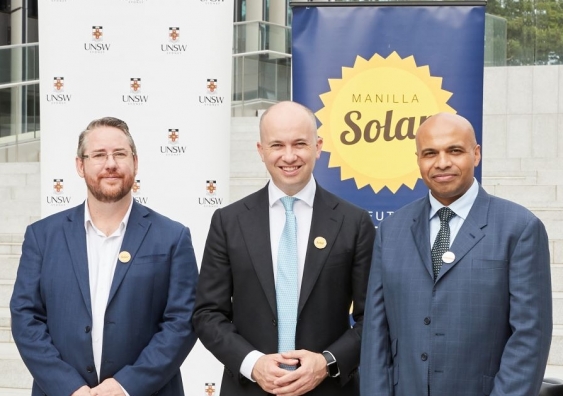
Disclaimer: These articles are not intended to provide medical advice, diagnosis or treatment. Views expressed here do not necessarily reflect those of Pittwater Online News or its staff.